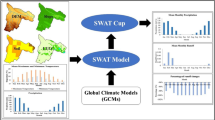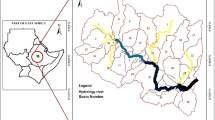Abstract
Based on the hydro-meteorological data over the past 50 years (1961–2010), the runoff change of the Kaidu River was predicted for the future 30 years (2011–2040). Two statistical downscaling models, the Statistical DownScaling Model (SDSM) and the Statistical Analog Resampling Scheme (STARS), were used to downscale the HadCM3 outputs for projecting the future climate scenarios of the basin. The Soil and Water Assessment Tool (SWAT) hydrological model was driven by the projected climate scenarios to generate the future runoff. Modeling results suggested that the SWAT model can well duplicate the recorded runoff changes in the basin and thus can be applied to simulation of future runoff changes. Both the SDSM and the STARS models performed well in simulating the temperature but relatively poorly in simulating the precipitation. Under the A2 and B2 scenarios the basin will experience a significant increasing trend in temperature and an indistinctive change trend in precipitation during the entire forecast period. Under the S1–S3 scenarios, both temperature and precipitation do not exhibit distinctive changes. In terms of river runoff, the predicted average annual runoff will be relatively abundant during the period from 2010s to 2020s but obviously short after 2020s under A2 scenario and will be kept relatively steady under B2 scenario. The predicted runoff will fluctuate drastically with no any significant trend under S1–S3 scenarios. The relatively high runoffs under S2–S3 scenarios seem to indicate the importance of temperature increasing in generating runoff. The scenario-based predictions suggest that moderate emission (e.g., B2) or moderate warming (e.g., S2) is beneficial to maintaining the expected level of runoff in the future.










Similar content being viewed by others
References
Abdo KS, Fiseha BM, Rientjes THM, Gieske ASM, Haile AT (2009) Assessment of climate change impacts on the hydrology of Gilgel Abay catchment in Lake Tana basin, Ethiopia. Hydrol Process 23:3661–3669
Chen YN, Cui WC, Li WH, Zhang YM (2003) Utilization of water resources and ecological protection in the Tarim River. Acta Geogr Sin 58(2):215–222 (in Chinese)
Chen L, Xu ZX, Luo R, Mi YJ (2009) SWAT application in arid and semi-arid region: a case study in the Kuye River basin. Geogr Res 28(1):65–73 (in Chinese)
Chen J, Brissette FP, Leconte R (2011) Uncertainty of downscaling method in quantifying the impact of climate change on hydrology. J Hydrol 401:190–202
Chen YN, Du Q, Chen YB (2013a) Sustainable water use in the Bosten Lake basin. Science Press, Beijing
Chen ZS, Chen YN, Li BF (2013b) Quantifying the effects of climate variability and human activities on runoff for Kaidu River Basin in arid region of northwest China. Theor Appl Climatol 111(3–4):537–545
Coquard J, Dun PB, Taylor KE (2004) Simulations of western U.S. surface climate in 15 global climate models. Clim Dyn 23:455–472
Deng MJ, Long AH (2011) Water resources issue among the Central Asia countries around the Aral Sea: conflict and cooperation. J Glaciol Geocryol 33(6):1376–1390 (in Chinese)
Duan K, Mei Y (2014) A comparison study of three statistical downscaling methods and their model-averaging ensemble for precipitation downscaling in China. Theor Appl Climatol 116:707–719
Fan ZL, Alishir K, Xu HL, Zhang QQ, Abdumijiti (2009) Changes of Tarim River and evolution of Lop Nur. Quat Sci 29(2):232–242 (in Chinese)
Gassman PW, Reyes MR, Green CH, Arnold JG (2007) The soil and water assessment tool: historical development, applications, and future research directions. Trans ASABE 50(4):1211–1250
Gupta HV, Sorooshian S, Yapo PO (1999) Status of automatic calibration for hydrologic models: comparison with multilevel expert calibration. J Hydrol Eng 4(2):135–143
Hu ZD, Wang L, Wang ZJ, HongY Zheng H (2015) Quantitative assessment of climate and human impacts on surface water resources in a typical semi-arid watershed in the middle reaches of the Yellow River from 1985 to 2006. Int J Climatol 35:97–113
Huang QH, Zhang WC (2010) Application and parameters sensitivity analysis of SWAT model. Arid Land Geogr 33(1):8–15 (in Chinese)
Huang J, Zhang JC, Zhang ZX, Xu CY, Wang BL, Yao J (2011) Estimation of future precipitation change in the Yangtze River basin by using statistical downscaling method. Stoch Environ Res Risk Assess 25:781–792
IPCC (2013) Working Group I Contribution to the Fifth Assessment Report of the Intergovernmental Panel on Climate Change. In: Stocker TF, Qin DH, Plattner GK, Tignor M, Allen SK, Boschung J, Nauels A, Xia Y, Bex V, Midgley PM (eds) Climate change 2013: the physical science basis. Cambridge University Press, Cambridge
Julia L, Friedrich WG (2015) Improving seasonal matching in the STARS model by adaptation of the resampling technique. Theor Appl Climatol 120(3–4):751–760
Kay AL, Davies HN, Bell VA, Jones RG (2009) Comparison of uncertainty sources for climate change impacts: flood frequency in England. Clim Change 92:41–63
Liu YJ, Tao FL (2012) Probabilistic Assessment and uncertainties analysis of climate change impacts on wheat biomass. Acta Geogr Sin 67(3):337–345 (in Chinese)
Lu ZX, Cai XH, Zou SB, Long AH, Xu BR (2012) Application of SWAT model in the upstream of Ili River Basin with scarce data. Arid Land Geogr 35(3):399–407 (in Chinese)
Moriasi DN, Arnold JG, Van Liew MW, Bingner RL, Harmel RD, Veith TL (2007) Model evaluation guidelines for systematic quantification of accuracy in watershed simulations. Trans ASABE 50(3):885–900
Myktybekovna SN, Chen YN, Salamat A (2014) Climate change and its impact on the hydrological processes of the Talas River in central Asia. Fresen Environ Bull 23(6):1423–1432
Nash JE, Sutcliffe JV (1970) River flow forecasting through conceptual models: part I. a discussion of principles. J Hydrol 10:282–290
Orlowsky B, Gerstengarbe FW, Werner PC (2008) A resampling scheme for regional climate simulations and its performance compared to a dynamical RCM. Theor Appl Climatol 92(3–4):209–223
Orlowsky B, Bothe O, Fraedrich K, Gerstengarbe FW, Zhu XH (2010) Future climates from bias-bootstrapped weather analogs: an application to the Yangtze River basin. J Clim 23(13):3509–3524
Orlowskya B, Fraedrich K (2009) Upscaling European surface temperatures to North Atlantic circulation-pattern statistics. Int J Climatol 29(6):839–849
Shi XY, Xu XD, Xu Y (2005) Comparison of temperature between six hundreds stations in China and output of IPCC models. Meteorology 31(7):49–53
Tao H, Wang GY, Shao C, Song YD, Zou SP (2007) Climate change and its effects on runoff at the headwater of Kaidu River. J Glaciol Geocryol 29(3):413–417 (in Chinese)
Taylor K (2005) IPCC Coupled Model Output for Working Group 1. In: Workshop on analysis of climate model simulations for IPCC AR4, Honolulu, Hawaii
Wang HJ, Chen YN, Li WH, Deng HJ (2013) Runoff responses to climate change in arid region of northwestern China during 1960–2010. Chin Geogr Sci 23(3):286–300
Wilby RL, Harris I (2006) A framework for assessing uncertainties in climate change impacts: low-flow scenarios for the River Thames, UK. Water Resour Res 42:W02419. doi:10.1029/2005WR004065
Wilby RL, Dawson CW, Barrow EM (2002) SDSM—a decision support tool for the assessment of regional climate change impacts. Environ Model Soft 17:147–159
Wu JL, Ma L, Jilili A (2009) Lake surface change of the Aral Sea and its environmental effects in the arid region of the Central Asia. Arid Land Geogr 32(3):418–422 (in Chinese)
Xia J, Liu CZ, Ren GY (2011) Opportunity and challenge of the climate change impact on the water resource of China. Adv Earth Sci 26(1):1–12 (in Chinese)
Xu JH, Chen YN, Ji MH, Lu F (2008) Climate change and its effects on runoff of Kaidu River, Xinjiang, China: a multiple timescale analysis. Chin Geogr Sci 18(4):331–339
Xu CC, Chen YN, Chen YP, Zhao RF, Ding H (2013) Responses of surface runoff to climate change and human activities in the arid region of Central Asia: a case study in the Tarim River basin, China. Environ Manag 51(4):926–938
Yuan GY, Yuan L (1998) An approach to the environmental changes in Lop-Nur history. Acta Geogr Sin 53(sup.):83–89 (in Chinese)
Zhang Q, Xu CY, Tao H, Chen David YQ (2010) Climate changes and their impacts on water resources in the arid regions: a case study of the Tarim River basin, China. Stoch Environ Res Risk Assess 24(3):349–358
Zhang XH, Yang DG, Xiang XY, Huang X (2012) Impact of agricultural development on variation in surface runoff in arid regions: a case of the Aksu River basin. J Arid Land 4(4):399–410 (in Chinese)
Zhang YN, Xu CC, Li WH, Zhao J (2014) Climate change characteristics and impacts on surface runoff in the Kaidu River Basin. Sci Soil Water Conserv 12(1):81–89 (in Chinese)
Zhao J, Xu CC, Gao ST, Li JX (2015) Hydrological modeling in the Urumqi River basin based on SWAT. Arid Land Geogr 38(4):666–674 (in Chinese)
Zuo DP, Xu ZX, Li JY, Liu ZF (2011) Spatiotemporal characteristics of potential evapotranspiration in the Weihe River basin under future climate change. Adv Water Sci 22:455–461 (in Chinese)
Acknowledgments
This study is jointly supported by the National Natural Science Foundation (Nos. 41561023, 41305125, 41271052) and the Open Fund of State Key Laboratory of Desert and Oasis Ecology, Xinjiang Institute of Ecology and Geography, Chinese Academy of Sciences (G2013-02-02). Thanks to the data sharing of the International Scientific Data Service Platform, Chinese Academy of Sciences (http://www.cnic.Cn/zcfw/sjfw/gjkxsjjx), the Environmental and Ecological Science Data Center in the West of China (http://westdc.westgis.ac.cn) and the China Meteorological Data Sharing Service System (http://data.cma.cn). Special thanks are owed to the editors and anonymous reviewers for their detailed and constructive comments.
Author information
Authors and Affiliations
Corresponding author
Additional information
This article is part of a Topical Collection in Environmental Earth Sciences on “Water in Central Asia,” guest edited by Daniel Karthe, Iskandar Abdullaev, Bazartseren Boldgiv, Dietrich Borchardt, Sergey Chalov, Jerker Jarsjö, Lanhai Li and Jeff Nittrouer.
Rights and permissions
About this article
Cite this article
Xu, C., Zhao, J., Deng, H. et al. Scenario-based runoff prediction for the Kaidu River basin of the Tianshan Mountains, Northwest China. Environ Earth Sci 75, 1126 (2016). https://doi.org/10.1007/s12665-016-5930-9
Received:
Accepted:
Published:
DOI: https://doi.org/10.1007/s12665-016-5930-9




